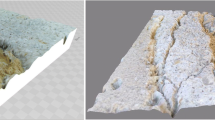Abstract
Thermal analysis techniques have been used in characterizing building materials from significant historic properties in the Charleston, South Carolina area. Determining the chemical and physical effects of deterioration resulting from long periods of exposure is a first step in formulating preservation strategies. In this regard, simultaneous thermal analysis coupled with evolved gas analysis has been used to study reactions between air, seawater, and masonry materials. Further, the traditional petrographic identification of mortar composition is greatly facilitated through use of thermal analysis. Simultaneous thermal analysis allows for an exact determination of the calcium carbonate content in mortars as an alternative to the use of an inferred value based on chemical analysis data. The partial dissolution of calcium carbonate in the presence of sea salt is a major deterioration process. Further, natural cements manufactured in the United States are identified, in part, based on their thermogravimetric (TG) traces and their evolved gases. The data indicates that natural cements form some carbonate phases in addition to the major hydrate phases. Clay bricks are found to exhibit interaction with sea water, with uptake of bicarbonate suggested. Additionally, there is evidence of re-hydroxylation in the 160 year old bricks. The bricks made in coastal zones contain a considerable free silica fraction that is composed of a small percentage of cristobalite. The silica content of the clay bricks is seen to result in very high thermal expansion coefficients in the area of 10 × 10−6 to 12 × 10−6 K−1. These studies provide guidance in restoration efforts where authenticity of cements is important. In the event that replacement bricks are required, matching the thermal expansion coefficient of the original bricks is a requirement for preservation of the masonry structure.










Similar content being viewed by others
References
Elsen J. Microscopy of historic mortars—a review. Cem Concr Res. 2006;36:1416–24.
Walsh J. Petrography: distinguishing natural cement from other binders in historical masonry construction using forensic microscopy techniques. J ASTM Int. 2007;4:20–31.
Standard test method for examination and analysis of hardened masonry mortar. ASTM C 1324-05, The American Society for Testing and Materials.
Damage Atlas: Classification and analysis of damage patterns found in brick masonry. ISBN 978-3816747024. Fraunhofer; 1998.
Moropoulou A, Bakolas A, Bisbikou K. Characterization of ancient, byzantine and later historic mortars by thermal and X-ray diffraction techniques. Thermochim Acta. 1995;269:779–95.
Chiari G, Torraca G, Santarelli M. Recommendations for systematic instrumental analysis of ancient mortars: the Italian experience. ASTM STP 1258, American Society for Testing and Materials. 1996; 275–84.
Iordanidis A, Garcia-Guinea J, Strati A, Gkimourtzina A, Papoulidou A. Thermal, mineralogical and spectroscopic study of plasters from three post-Byzantine churches from Kastoria (northern Greece). J Therm Anal Calorim. 2011;103:577–86.
Krotzer D, Walsh J. Analyzing mortars and stuccos at the College of Charleston: a comprehensive approach. J Preserv Technol. 2009;40:37–44.
Kaisersberger E, Post E. Practical aspects of the coupling of gas analytical methods with thermal-analysis instruments. Thermochim Acta. 1997;295:73.
Lubelli B, van Hees R, Groot C. The role of sea salts in the occurrence of different damage mechanisms and decay patterns on brick masonry. Constr Build Mater. 2004;18:119–24.
Gosselin C, Verges-Belmin V, Royer A, Martinet G. Natural cement and monumental restoration. Mater Struct. 2009;42:749–63.
Hughes D, Jaglin D, Kozlowski R, Mucha D. Roman cements—belite cements calcined at low temperatures. Cem Concr Res. 2009;39:77–89.
Pavia S. The determination of brick provenance and technology using analytical techniques from the physical sciences. Archaeometry. 2006;48:201–18.
Traoré K, Kabré T, Blanchard P. Gehlenite and anorthite crystallization from kaolinite and calcite mix. Ceram Int. 2003;29:377–83.
Frost R, Erickson K. Thermal decomposition of natural iowaite. J Therm Anal Calorim. 2004;78:367–78.
Wilson M, Carter M, Hall C, Hoff W, Ince C, Savage S, Mckay B, Betts T. Dating fired-clay ceramics using long-term power law rehydroxylation kinetics. Proc R Soc A. 2009;2009(465):2407–15.
Author information
Authors and Affiliations
Corresponding author
Rights and permissions
About this article
Cite this article
Brosnan, D.A., Sanders, J.P. & Hart, S.A. Application of thermal analysis in preservation and restoration of historic masonry materials. J Therm Anal Calorim 106, 109–115 (2011). https://doi.org/10.1007/s10973-011-1422-z
Published:
Issue Date:
DOI: https://doi.org/10.1007/s10973-011-1422-z




